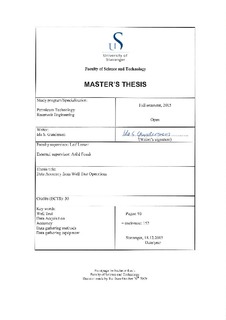| dc.contributor.author | Gundersen, Ida Stuksrud | |
| dc.date.accessioned | 2016-10-21T08:05:23Z | |
| dc.date.available | 2016-10-21T08:05:23Z | |
| dc.date.issued | 2015-12-18 | |
| dc.identifier.uri | http://hdl.handle.net/11250/2416801 | |
| dc.description | Master's thesis in Petroleum engineering | nb_NO |
| dc.description.abstract | This master thesis presents a study on data accuracy from well test operations. All data measuring
methods, except bottomhole and surface PVT sampling, is investigated for the accuracy related to
procedure and equipment used. The objectives with this study is to highlight potential weaknesses in
the procedures or equipment so that Expro can improve the quality of their data acquisition.
The main research area is the measurement methods, but also the impact of the type of fluids produced
has been studied. Oil, gas or gas/condensate may have different inaccuracies for different methods.
Results from this study shows that some of the measurements should be improved. The most critical
measurement is the oil flow rate, where no procedure for executing meter correction factor is given. Oil
flow rate is one of the most important surface parameters the client want obtain with a well test and
should therefor be as accurate as possible. Another weakness is an Excel spreadsheets that is used for
various calculations for oil is not protected and formulas has been manipulated. This may again give
wrong output values.
Another factor is the lack of knowledge among offshore personnell about phase changes due to changes
in pressure and temperature. This may have impact on all the measurements that include gas and oil.
Since this is something they can not expect offshore personnell to be experts on, should the procedures
be updated to cover all scenarios for measurements of various phases.
The conclusion from this study is that measurements regarding oil and gas parameter are the most
inaccurate and an update of procedures is necessary to improve the data accuracy. Most of the
calculations today is done by computer softwares, but correct input values is necessary to get correct
output values. Knowledge about what formulas the software contain is important to know to be able to
make necessary measurement and data collection for input variables to the software. This should be
taken into account if procedure is to updated. | nb_NO |
| dc.language.iso | eng | nb_NO |
| dc.publisher | University of Stavanger, Norway | nb_NO |
| dc.relation.ispartofseries | Masteroppgave/UIS-TN-IPT/2015; | |
| dc.subject | reservoir engineering | nb_NO |
| dc.subject | petroleum technology | nb_NO |
| dc.subject | petroleumsteknologi | nb_NO |
| dc.subject | well test | nb_NO |
| dc.subject | brønnteknologi | nb_NO |
| dc.title | Data Accuracy from Well Test Operations | nb_NO |
| dc.type | Master thesis | nb_NO |
| dc.subject.nsi | VDP::Technology: 500::Rock and petroleum disciplines: 510::Petroleum engineering: 512 | nb_NO |
